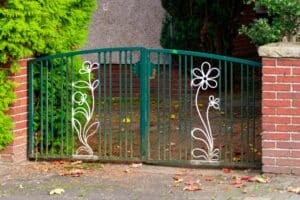In today’s world, the importance of home security cannot be overstated. With the rise in residential break-ins and property crimes, homeowners are more conscious than ever about safeguarding their homes and loved ones. This growing concern has led to the exploration of various security measures, among which the combination of traditional ironwork and modern surveillance systems stands out as a comprehensive solution. Traditional ironwork, with its robust and imposing nature, offers a physical barrier to potential intruders, while the advanced technology of surveillance systems provides a digital eye, keeping a watchful gaze over your property. Together, these two components form a formidable front against security breaches, blending the time-honored strength of iron with the cutting-edge capabilities of modern surveillance. This synergy not only enhances the security of a home but also adds to the peace of mind for homeowners.
Understanding Ironwork in Home Security
A. History and Evolution of Ironwork for Security Ironwork has been a cornerstone in home security for centuries, evolving from basic metal bars to intricate designs. Originally, iron bars were used for their strength and durability, offering a simple yet effective way to secure homes from unwanted intruders. Over time, this evolved into more elaborate and decorative forms, not only enhancing security but also adding aesthetic value to properties. Today, ironwork combines these traditional techniques with modern designs, offering both beauty and robust protection.
B. Different Types of Ironwork Solutions
- Iron Gates and Fences: These are the first line of defense in home security. Iron gates can be custom-designed to suit the style of the home while providing a formidable barrier. Fences made of iron not only mark the boundary of a property but also act as a deterrent to trespassers due to their sturdy construction and often sharp, pointed designs.
- Window Grills and Door Reinforcements: Window grills made of iron provide additional security for vulnerable entry points. These grills can be crafted in various designs, ranging from simple bars to intricate patterns. Door reinforcements, such as iron frames and deadbolt locks, further enhance the security of entry doors, making them more resistant to forced entry.
C. Advantages of Ironwork in Deterrence and Physical Security The primary advantage of ironwork lies in its physical strength and durability, which acts as a significant deterrent to potential intruders. It provides a physical barrier that is difficult to breach without specialized tools or significant effort. Additionally, the visible presence of ironwork itself can discourage burglars from targeting a home, as it signifies a well-secured property.
Tip: Temporary fencing can be used when security is only needed for short periods of time.
The Rise of Surveillance Systems
A. Overview of Modern Home Surveillance Technologies Modern home surveillance systems have come a long way, incorporating high-definition cameras, motion sensors, and advanced software analytics. These systems can range from basic camera setups to comprehensive systems that cover every corner of a property. Innovations in camera technology, such as night vision and wide-angle lenses, have further enhanced the effectiveness of these systems.
B. Benefits of Surveillance Systems
- Remote Monitoring Capabilities: One of the most significant advantages of modern surveillance systems is the ability to monitor your home remotely. Through internet connectivity, homeowners can view live feeds, receive alerts, and even communicate through two-way audio via their smartphones or other devices.
- Integration with Smart Home Systems: Surveillance systems can now be integrated with smart home technologies, allowing for automated responses like lights turning on when motion is detected or doors locking automatically.
C. Choosing the Right Surveillance System
- Camera Types and Features: Selecting the right camera is crucial. Options include bullet cameras, dome cameras, and PTZ (pan, tilt, zoom) cameras, each offering different features like wide-angle viewing, zoom capabilities, and varying degrees of weather resistance.
- Connectivity and Storage Options: Modern systems offer various connectivity options, including Wi-Fi, Bluetooth, and wired connections. Storage can be local on memory cards or hard drives, or in the cloud for easier access and increased storage capacity.
Together, the combination of ironwork and surveillance systems creates a multi-layered security strategy, addressing both physical barriers and digital monitoring to ensure maximum protection for homes.
Combining Ironwork with Surveillance Systems
A. How Ironwork Complements Surveillance Ironwork and surveillance systems, when combined, offer a synergistic approach to home security. Ironwork serves as a physical barrier, deterring and delaying intruders, while surveillance systems provide real-time monitoring and evidence collection. This combination ensures that while ironwork physically fortifies the property, surveillance systems add an extra layer of security through constant vigilance and recording capabilities.
B. Strategic Placement for Maximum Security
- Tips for Positioning Cameras and Ironwork: The key to maximizing the effectiveness of this combination is strategic placement. Cameras should be positioned to cover all ironwork installations like gates, fences, and window grills. This ensures that any attempt to tamper with or breach the ironwork is captured on video. Additionally, placing cameras at high vantage points with a clear view of the ironwork will provide broader coverage and reduce blind spots.
- Ensuring Visibility and Coverage: Visibility is crucial for both ironwork and surveillance cameras. Ironwork should not obstruct camera views, and similarly, cameras should be installed in a way that they are not easily tampered with or obstructed by environmental elements. Adequate lighting should be considered to enhance visibility, especially for night-time surveillance.
C. Examples of Effective Ironwork and Surveillance Combinations
- A gated property with cameras positioned at the gate and along the perimeter fence.
- Window grills with nearby outdoor cameras providing a clear view of all entry points.
- Door reinforcements with doorbell cameras or overhead surveillance for a complete view of anyone approaching the door.
DIY Tips vs. Professional Installation
A. Assessing Your Skill Level and Resources Before deciding between a DIY installation and professional help, assess your own skills and the complexity of the system you intend to install. Consider the tools and time you have available, as well as your comfort level with technical tasks.
B. Advantages of Professional Installation Professional installation ensures that the system is set up correctly and efficiently. Professionals can offer expert advice on the best locations for cameras and ironwork, and they can often provide more advanced installation options that might be challenging for a DIY approach.
C. Steps for DIY Enthusiasts
- Planning and Design: Start with a detailed plan of your property, identifying key areas for surveillance and ironwork installation. Consider the field of view for cameras and how ironwork can be integrated without hindering surveillance.
- Necessary Tools and Materials: Ensure you have all the required tools and materials before beginning. This may include drills, screws, wall plugs, cameras, ironwork pieces, and wiring or wireless components.
- Safety Considerations: Safety is paramount. When installing cameras at height, use appropriate ladders or scaffolding and follow electrical safety guidelines. When handling ironwork, wear protective gear to avoid injuries.
Whether opting for DIY or professional installation, the goal is to create a seamless and effective combination of ironwork and surveillance systems that enhances the overall security of your home.
Maintenance and Upkeep
A. Routine Maintenance for Ironwork Regular maintenance of ironwork is essential to ensure its longevity and effectiveness. This includes periodic inspections for rust or damage, particularly in areas exposed to weather or moisture. Applying rust-resistant coatings and performing touch-up painting can prevent corrosion. Hinges, locks, and other moving parts in gates or grills should be lubricated regularly to ensure smooth operation.
B. Keeping Surveillance Systems Operational Surveillance systems require consistent upkeep to function optimally. This includes cleaning camera lenses to ensure clear visibility, checking for any physical damages, and ensuring that the software and firmware are up-to-date. Regularly testing the system, including motion sensors and night vision capabilities, is crucial for detecting any faults or issues that may require attention.
C. Upgrading and Updating Security Systems As technology evolves, upgrading your security system might become necessary to ensure maximum protection. This could involve adding more advanced cameras, integrating your system with newer smart home technology, or updating the software for better functionality and security features. Regularly reviewing and assessing the system’s performance can help identify when an upgrade is needed.
Legal Considerations and Neighborhood Impact
A. Understanding Local Regulations Before installing surveillance systems and ironwork, it’s important to be aware of local regulations and building codes. Some areas may have restrictions on the type of surveillance equipment that can be used or the height and design of iron fences and gates. Obtaining necessary permits and ensuring compliance with local laws can prevent legal issues and potential fines.
B. Balancing Security and Privacy Concerns While enhancing home security, it’s also crucial to respect the privacy of neighbors. Surveillance cameras should be positioned to monitor your property without intruding into neighboring properties or public spaces. Informing neighbors about your security systems can help maintain good relations and avoid privacy concerns or disputes.
C. The Effect on Community and Property Value The installation of security measures like ironwork and surveillance systems can impact the community and property values in various ways. On one hand, these enhancements can make a neighborhood more attractive to potential buyers, raising property values. On the other hand, overly extensive security measures might create an impression of a high-crime area, which could negatively impact perceptions of the neighborhood. Balancing security needs with aesthetic considerations and community ambiance is therefore important.
In conclusion, the strategic integration of ironwork and surveillance systems represents a powerful approach to enhancing home security. By combining the physical strength and deterrent qualities of ironwork with the monitoring and technological sophistication of surveillance systems, homeowners can create a robust and effective defense against potential security breaches. Regular maintenance and timely upgrades ensure these systems remain effective and adapt to evolving security needs.
However, it’s not just about installing these measures; it’s about doing so responsibly and thoughtfully. Homeowners must navigate the balance between security and privacy, and adhere to local regulations, all while considering the broader impact on the neighborhood and community. Thoughtful implementation of these security measures can not only provide peace of mind but can also contribute positively to the community’s character and property values.
Ultimately, the goal is to create a safe and secure environment that respects both individual and communal needs. By paying attention to both the technical and social aspects of home security, one can effectively protect their home while maintaining a harmonious relationship with the surrounding community.


